Charles E W Bean, Diaries, AWM38 3DRL 606/253/1 - 1918 - 1939 - Part 7
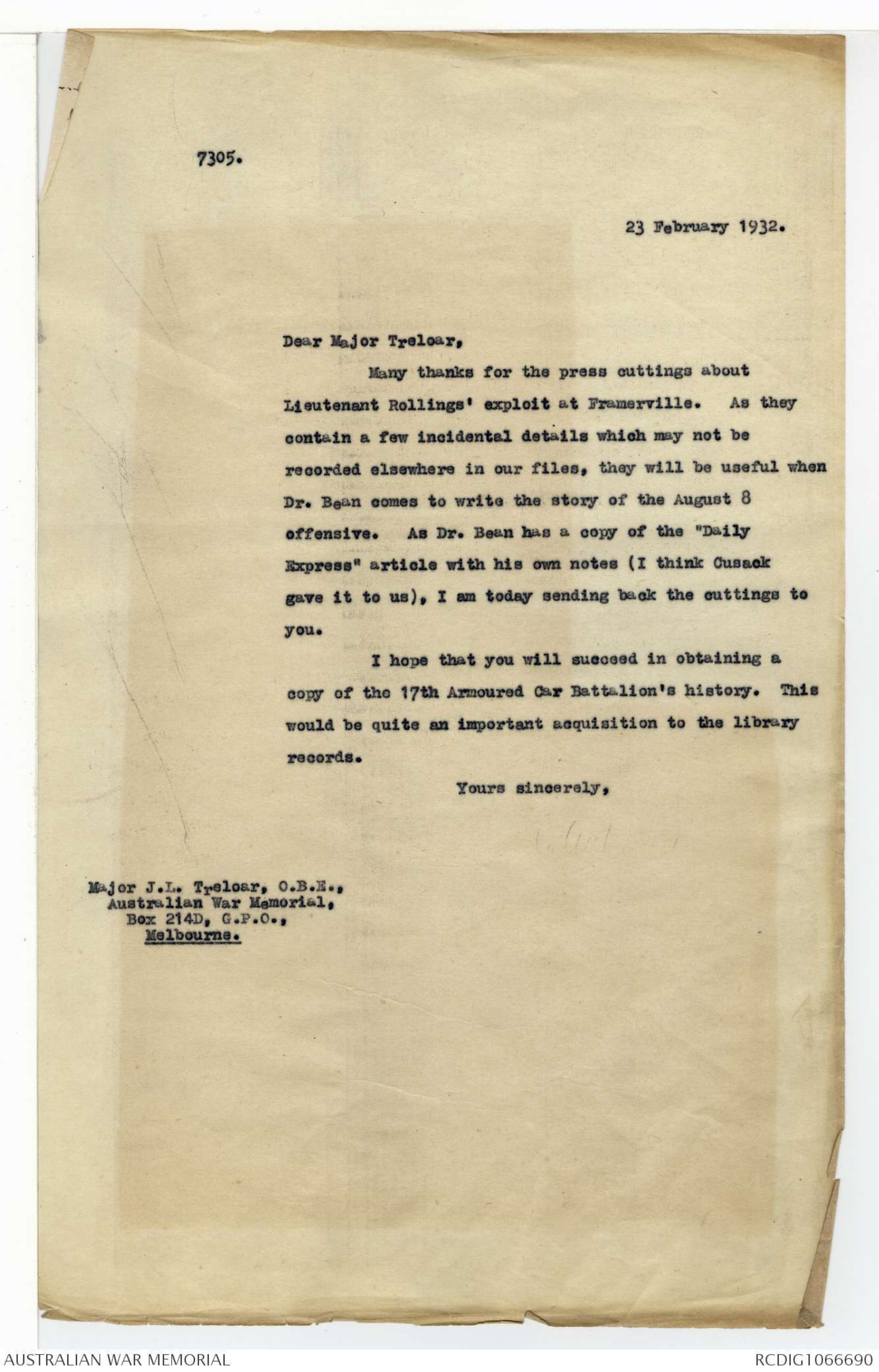
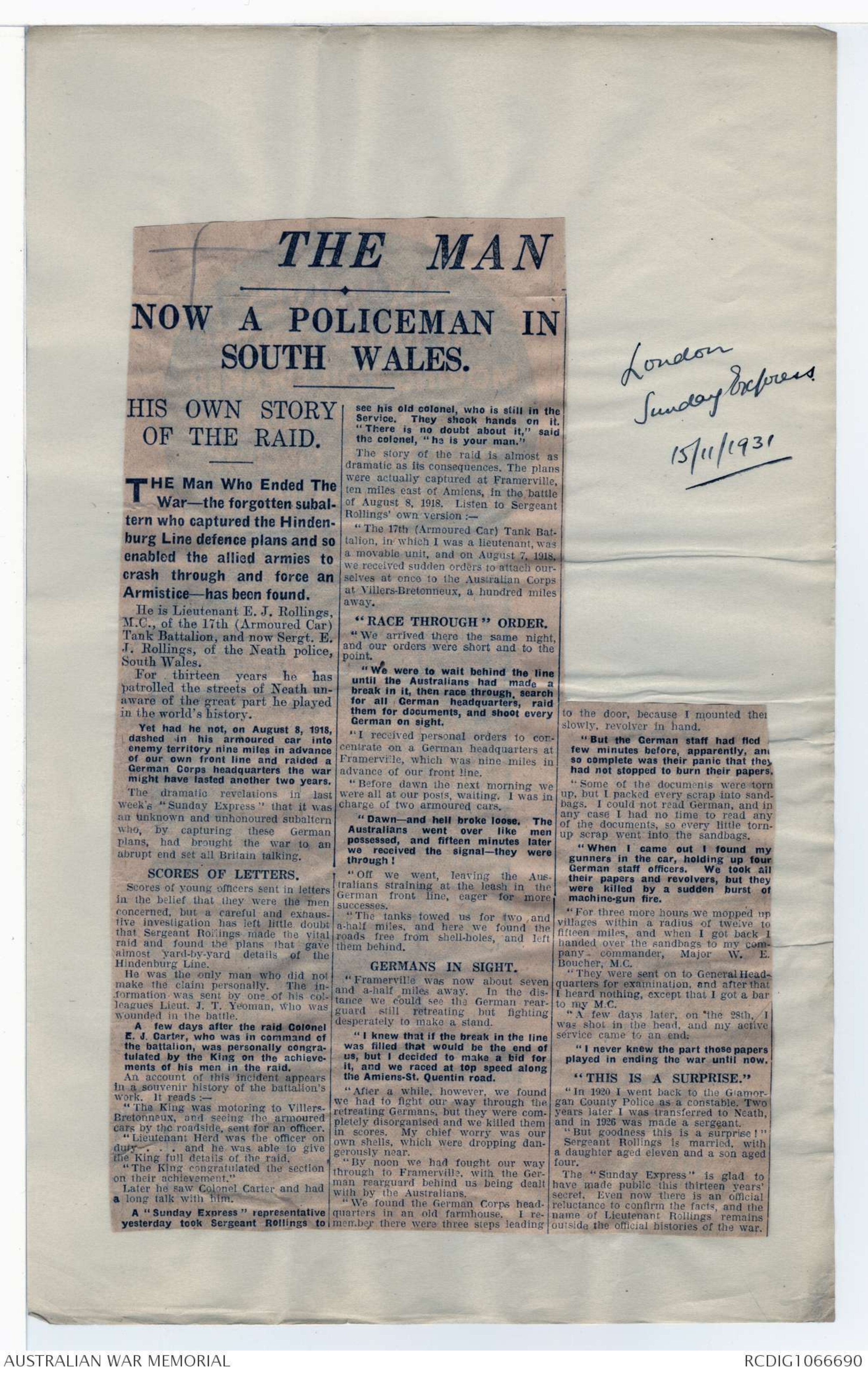
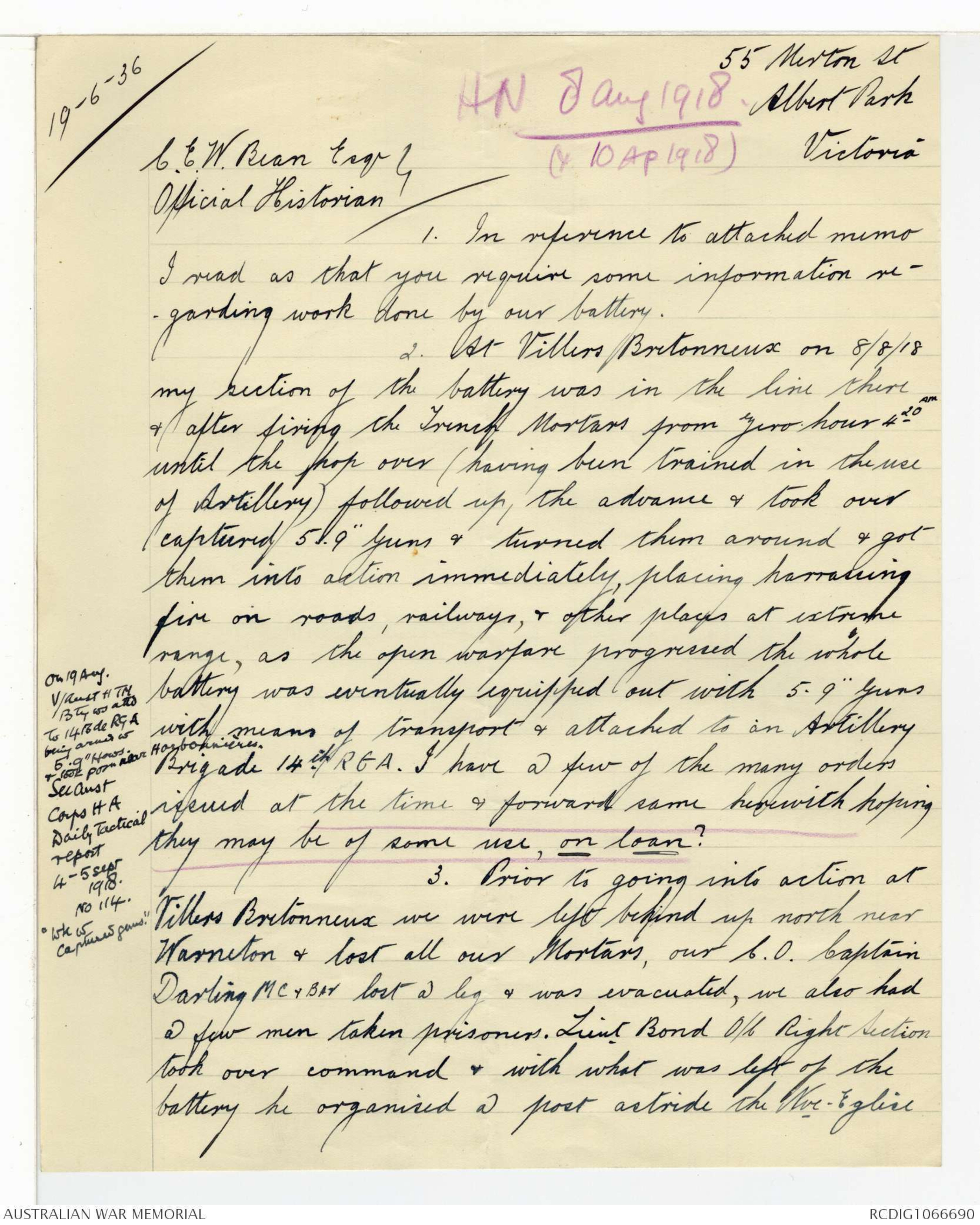
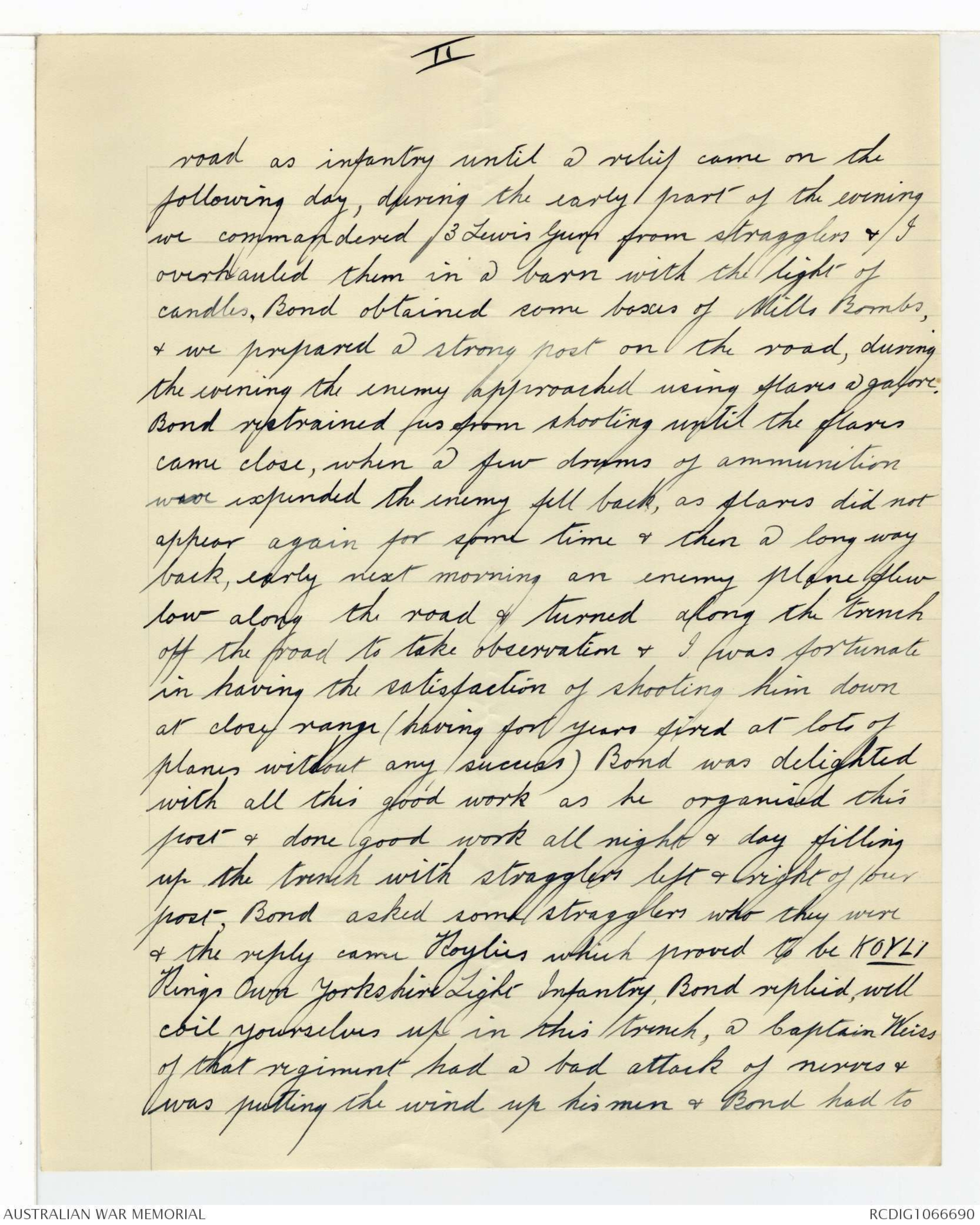

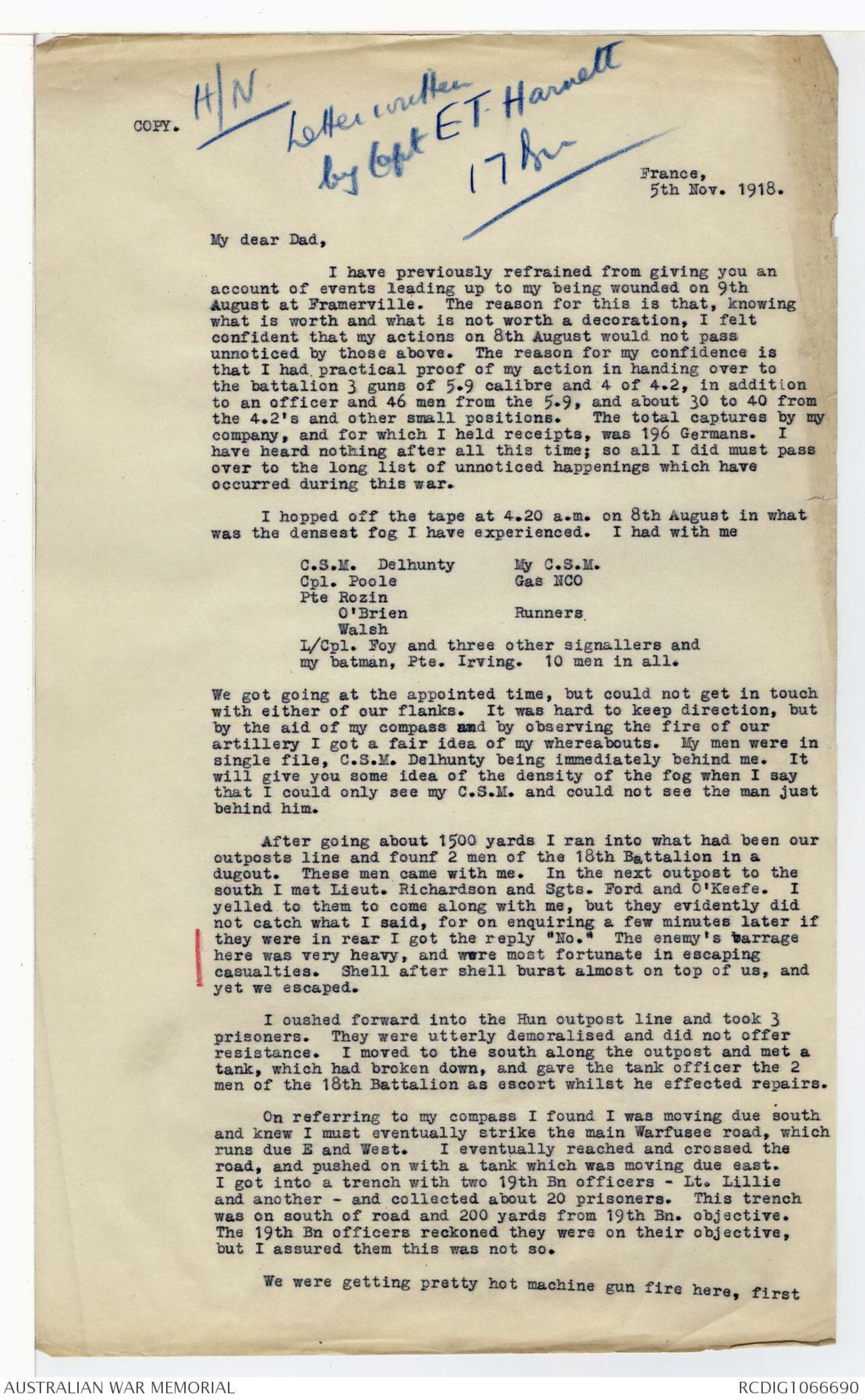
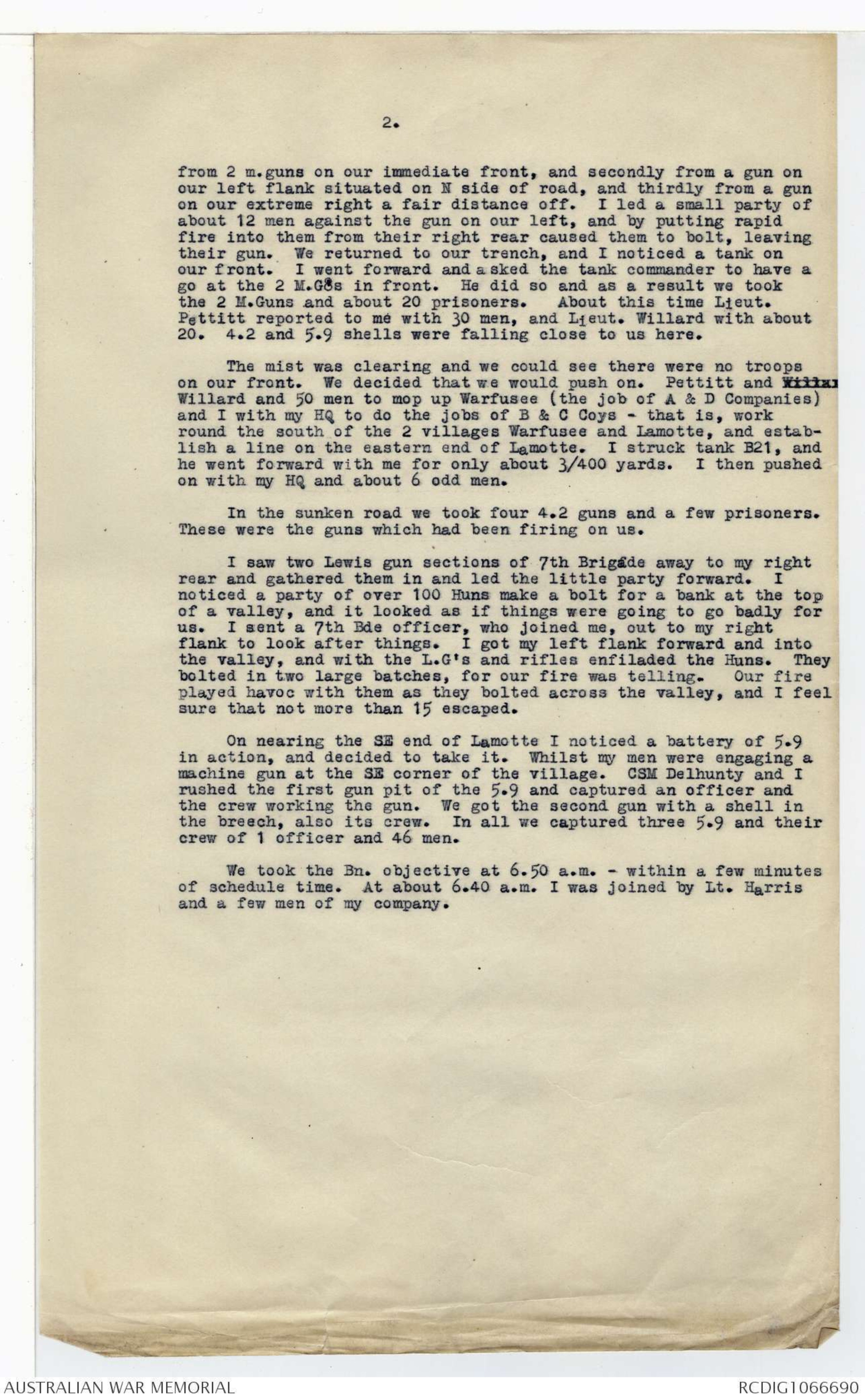
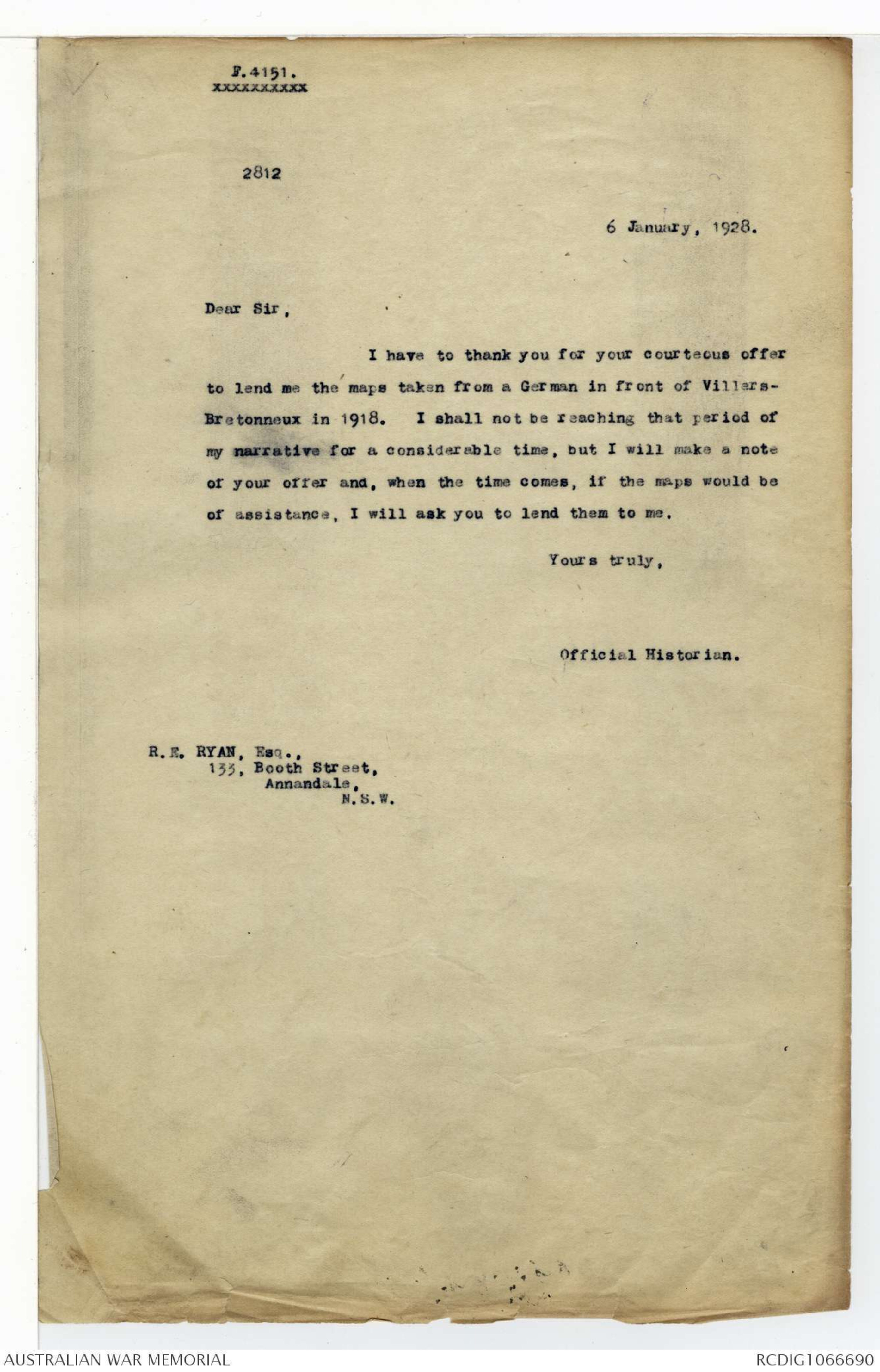
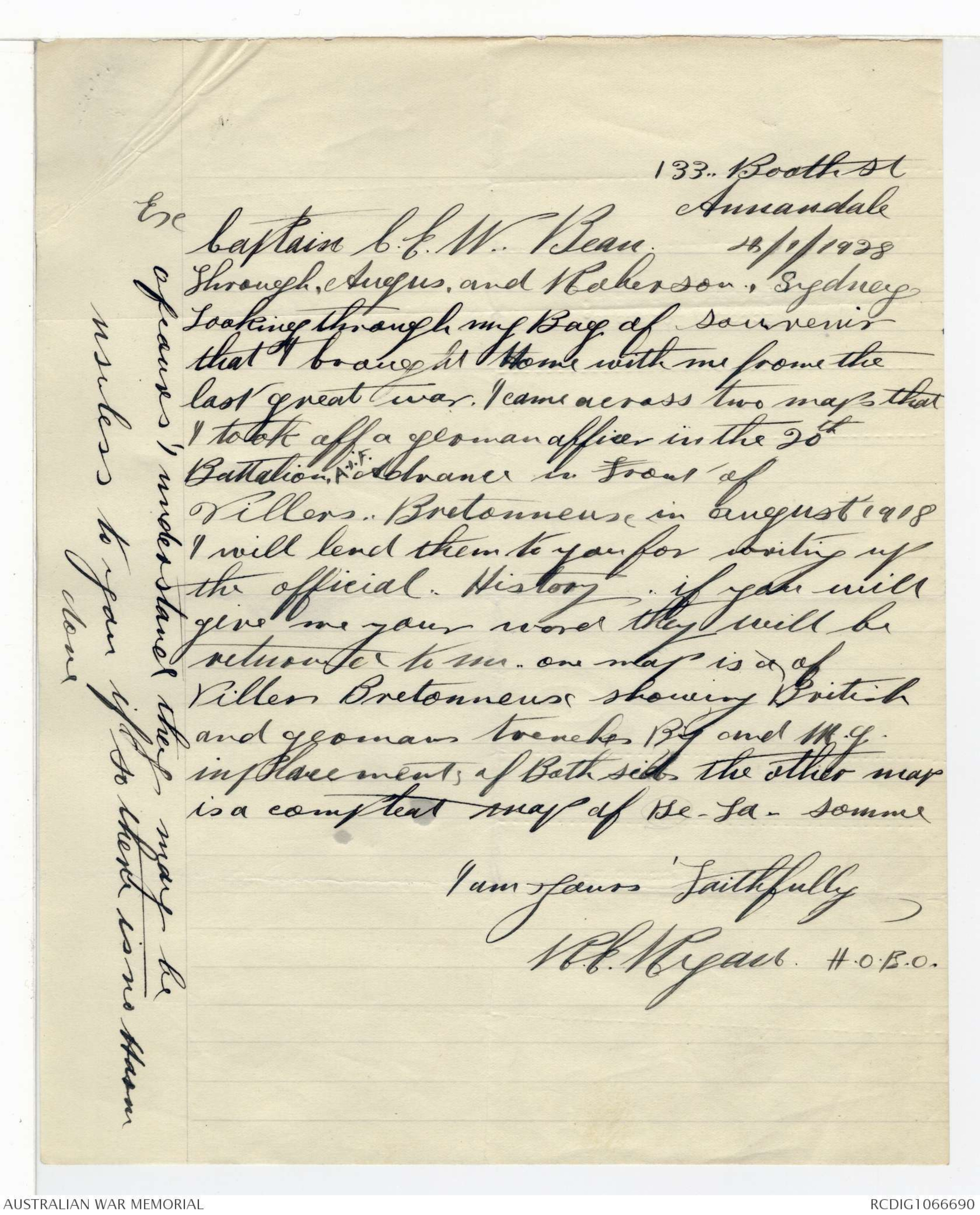
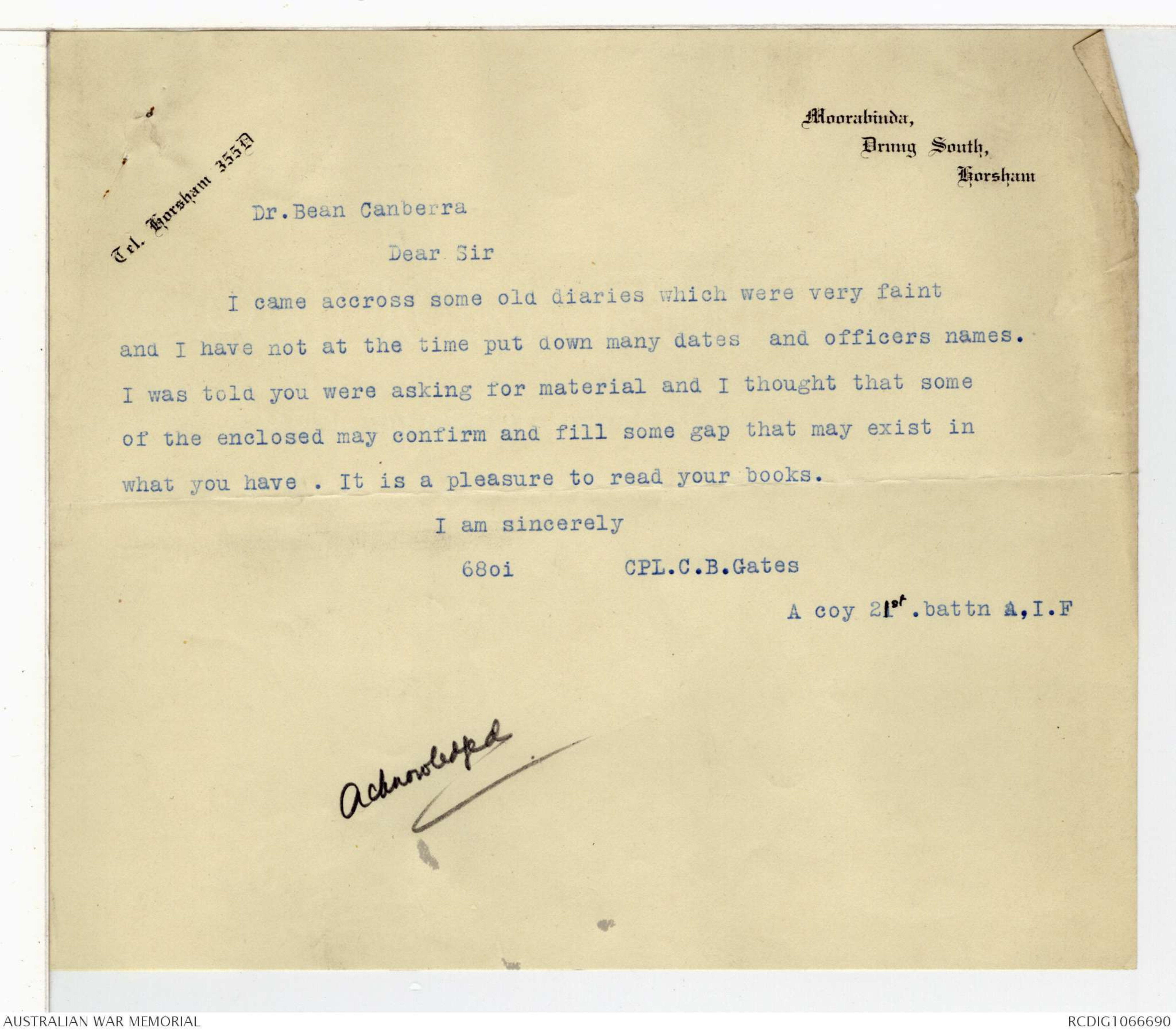
7305.
23 February 1932.
Dear Major Treloar,
Many thanks for the press cuttings about
Lieutenant Rollings' exploit at Framerville. As they
contain a few incidental details which may not be
recorded elsewhere in our files, they will be useful when
Dr. Bean comes to write the story of the August 8
offensive. As Dr. Bean has a copy of the "Daily
Express" article with his own notes (I think Cusack
gave it to us), I am today sending back the cuttings to
you.
I hope that you will succeed in obtaining a
copy of the 17th Armoured Car Battalion's history. This
would be quite an important acquisition to the library
records.
Yours sincerely,
Major J.L. Treloar, O.B.E.,
Australian War Memorial,
Box 214D, G.P.O.,
Melbourne.
London
Sunday Express
15/11/1931
THE MAN
NOW A POLICEMAN IN
SOUTH WALES.
HIS OWN STORY
OF THE RAID.
The man Who Ended The
War - the forgotten subaltern
who captured the Hindenburg
Line defence plans and so
enabled the allied armies to
crash through and force an
Armistice - has been found.
He is Lieutenant E.J.Rollings,
M.C., of the 17th (Armoured Car)
Tank Battalion, and now Sergt.E.J.
Rollings, of the Neath police,
South Wales.
For thirteen years he has
patrolled the streets of Neath unaware
of the great part he played
in the world's history.
Yet had he not, on August 8, 1918,
dashed in his armoured car into
enemy territory nine miles in advance
of our own front line and raided a
German Corps headquarters the war
might have lasted another two years.
The dramatic revelations in last
week's "Sunday Express" that it was
an unknown and unhonoured subaltern
who, by capturing these German
plans, had brought the war to an
abrupt end set all Britain talking.
SCORES OF LETTERS.
Scores of young officers sent in letters
in the belief that they were the men
concerned, but a careful and exhaustive
investigation has left little doubt
that Sergeant Rollings made the vital
raid and found the plans that gave
almost yard-by-yard details of the
Hindenburg Line.
He was the only man who did not
make the claim personally. The information
was sent by one of his colleagues
Lieut. J.T. Yeoman, who was
wounded in the battle.
A few days after the raid Colonel
E.J.Carter, who was in command of
the battalion, was personally congratulated
by the King on the achievements
of his men in the raid.
An account of this incident appears
in a souvenir history of the battalion's
work. It reads :-
"The King was motoring to Villers-
Bretonneux, and seeing the armoured
cars by the roadside, sent for an officer.
"Lieutenant Herd was the officer on
duty . . . . and he was able to give
the King full details of the raid.
"The King congratulated the section
on their achievement".
Later he saw Colonel Carter and had
a long talk with him.
A "Sunday Express" representative
yesterday took Sergeant Rollings to
see his old colonel who is still in the
Service. They shook hands on it.
"There is no doubt about it," said
the colonel, "he is your man".
The story of the raid is almost as
dramatic as its consequences. The plans
were actually captured at Framerville,
ten miles east of Amiens, in the battle
of August 8, 1918. Listen to Sergeant
Rollings' own version:-
"The 17th (Armoured Car) Tank Battalion,
in which I was a lieutenant, was
a movable unit, and on August 7, 1918,
we received sudden orders to attach ourselves
at once to the Australian Corps
at Villers-Bretonneux, a hundred miles
away.
"RACE THROUGH" ORDER.
"We arrived there the same night,
and our orders were short and to the
point.
"We were to wait behind the line
until the Australians had made a
break in it, then race through, search
for all German headquarters, raid
them for documents, and shoot every
German on sight.
"I received personal orders to concentrate
on German headquarters at
Framerville, which was nine miles in
advance of our front line.
"Before dawn the next morning we
were all at our posts waiting. I was in
charge of two armoured cars.
"Dawn -and hell broke loose. The
Australians went over like men
possessed, and fifteen minutes later
we received the signal-they were
through!
"Off we went, leaving the Australians
straining at the leash in the
German front line, eager for more
successes.
"The tanks towed us for two and
a half miles, and here we found the
roads free from shell-holes, and left
them behind.
GERMANS IN SIGHT.
"Framerville was now about seven
and a half miles away. In the distance
we could see the German rearguard
still retreating but fighting
desperately to make a stand.
"I knew that if the break in the line
was filled that would be the end of
us, but I decided to make a bid for
it, and we raced at top speed along
the Amiens-St.Quentin road.
"After a while, however, we found
we had to fight our way through the
retreating Germans, but they were completely
disorganised and we killed them
in scores. My chief worry was our
own shells, which were dropping dangerously
near.
"By noon we had fought our way
through to Framerville, with the German
rearguard behind us being dealt
with by the Australians.
"We found the German Corps headquarters
in an old farmhouse. I remember
there were three steps leading
to the door, because I mounted them
slowly, revolver in hand.
"But German staff had fled
few minutes before, apparently, and
so complete was their panic that they
had not stopped to burn their papers.
"Some of the documents were torn
up, but I packed every scrap into sandbags.
I could not read German, and in
any case I had no time to read any
of the documents, so every little torn-
up scrap went into the sandbags.
"When I came out I found my
gunners in the car, holding up four
German staff officers. We took all
their papers and revolvers, but they
were killed by a sudden burst of
machine-gun fire.
"For three more hours we mopped up
villages within a radius of twelve to
fifteen miles, and when I got back I
handed over the sandbags to my
company commander, Major W.E.
Boucher, M.C,.
"They were sent on to General Head-
quarters for examination, and after that
I heard nothing, except that I got a bar
to my M.C.
"A few days later, on the 28th, I
was shot in the head, and my active
service came to an end.
"I never knew the part those papers
played in ending the war until now.
"THIS IS A SURPRISE"
"In 1920 I went back to the Glamorgan
County Police as a constable. Two
years later I was transferred to Neath,
and in 1926 was made a sergeant.
"But goodness this is a surprise!"
Sergeant Rollings is married, with
a daughter aged eleven and a son aged
four.
The "Sunday Express" is glad to
have made public this thirteen years'
secret. Even now there is an official
reluctance to confirm the facts, and the
name of Lieutenant Rollings remains
outside the official histories of the war.
19-6-36
HN 8 AUG 1918
(x 10 Ap 1918)
55 Merton St
Albert Park
Victoria
C.E.W.Bean Esq }
Official Historian}
- In reference to attached memo
I read as that you require some information regarding
work done by our battery.
2. At Villers Bretonneux on 8/8/18
my section of the battery was in the line there
& after firing the Trench Mortars from Zero hour 4.20 AM
until the prop over (having been trained in the use
of Artillery) followed up, the advance & took over
captured 5.9" Guns & turned them around & got
them into action immediately placing harrassing
fire on roads, railways, & other places at extreme
range, as the open warfare progressed the whole
battery was eventually equipped out with 5.9" Guns
with means of transport & attached to an Artillery
Brigade 14th RGA. I have a few of the many orders
issued at the time & forward some herewith hoping
they may be of some use, on loan?
[[*On 19 Aug. V/Aust HTM Bty sw attd
to 14 Bde RGA being armed w
5.9" Hows. & took posn above.
See Aust Corps H A Daily Tactical report
4-5 Sept 1918. No 114. "Wk w captured guns."*]]
3. Prior to going into action at
Villers Bretonneux we were left behind up north near
Warneton & lost all our Mortars, our C.O. Captain
Darling MC & BAY lost a leg & was evacuated, we also had
a few men taken prisoners. Lieut Bond O/C Right Section
took over command & with what was left of the
battery he organised a post astride the Ave-Eglise
II
road as infantry until a relief came on the
following day, during the early part of the evening
we commandered 3 Lewis Guns from stragglers & I
overhauled them in a barn with the light of
candles, Bond obtained some boxes of Mills Bombs,
& we prepared a strong post on the road, during
the evening the enemy approached using flares a galore.
Bond restrained us from shooting until the flares
came close, when a few drums of ammunition
were expended the enemy fell back, as flares did not
appear again for some time & then a long way
back, early next morning an enemy plane flew
low along the road & turned along the trench
off the road to take observation & I was fortunate
in having the satisfaction of shooting him down
at close range (having for years fired at lots of
planes without any success) Bond was delighted
with all this good work as he organised this
post & done good work all night & day filling
up the trench with stragglers left & right of our
post, Bond asked some stragglers who they were
& the reply came Roylies which proved to be KOYLI
Kings Own Yorkshire Light Infantry, Bond replied well
coil yourselves up, in this trench, a Captain Weiss
of that regiment had a bad attack of nerves &
was putting the wind up his men & Bond had to
III
hold him down in the trench when the flares
started to fall close to us during the night, he
would have it that we were surrounded. I am
sure Bond could give some good information of
all this, no one in authority ever knew of our
episode there, we were eventually relieved &
re-equipped with Mortars & sent in at Villiers Bretonneux
as previously stated. I saw Bond about 2 years ago
& he was then a farmer. F Bond Mitiamo
Victoria, hoping this is something you were
asking for & let me have papers back.
Yours truly
H.L. Newland
Bty was comtd by BGHA gocRA
1 X Corps.
18 Ap 1918.
H/N
Letter written by Cpt E.T.Harnett
17 Bn
COPY.
France,
5th Nov. 1918.
My dear Dad,
I have previously refrained from giving you an
account of events leading up to my being wounded on 9th
August at Framerville. The reason for this is that, knowing
what is worth and what is not worth a decoration, I felt
confident that my actions on 8th August would not pass
unnoticed by those above. The reason for my confidence is
that I had practical proof of my action in handing over to
the battalion 3 guns of 5.9 calibre and 4 of 4.2, in addition
to an officer and 46 men from the 5.9, and about 30 to 40 from
the 4.2's and other small positions. The total captures by my
company, and for which I held receipts, was 196 Germans. I
have heard nothing after all this time; so all I did must pass
over to the long list of unnoticed happenings which have
occurred during this war.
I hopped off the tape a 4.20 a.m. on 8th August in what
was the densest fog I have experienced. I had with me
C.S.M. Delhunty My C.S.M.
Cpl. Poole Gas NCO
Pte Rozin
O'Brien Runners
Walsh
L/Cpl. Foy and three other signallers and
my batman, Pte. Irving. 10 men in all.
We got going at the appointed time, but could not get in touch
with either of our flanks. It was hard to keep direction, but
by the aid of my compass and by observing the fire of our
artillery I got a fair idea of my whereabouts. My men were in
single file, C.S.M. Delhunty being immediately behind me. It
will give you some idea of the density of the fog when I say
that I could only see my C.S.M. and could not see the man just
behind him.
After going about 1500 yards I ran into what had been our
outposts line and found 2 men of the 18th Battalion in a
dugout. These men came with me. In the next outpost to the
south I met Lieut. Richardson and Sgts. Ford and O'Keefe. I
yelled to them to come along with me, but they evidently did
not catch what I said, for on enquiring a few minutes later if
they were in rear I got the reply "No". The enemy's barrage
here was very heavy, and were most fortunate in escaping
casualties. Shell after shell burst almost on top of us, and
yet we escaped.
I oushed forward into the Hun outpost line and took 3
prisoners. They were utterly demoralised and did not offer
resistance. I moved to the south along the outpost and met a
tank, which had broken down, and gave the tank officer the 2
men of the 18th Battalion as escort whilst he effected repairs.
On referring to my compass I found I was moving due south
and knew I must eventually strike the main Warfusee road, which
runs due E and West. I eventually reached and crossed the
road, and pushed on with a tank which was moving due east.
I got into a trench with two 19th Bn officers - Lt.Lillie
and another - and collected about 20 prisoners. This trench
was on south of road and 200 yards from 19th Bn. objective.
The 19th Bn officers reckoned they were on their objective.
but I assured them this was not so.
We were getting pretty hot machine gun fire here, first
2.
from 2 m.guns on our immediate front, and secondly from a gun on
our left flank situated on N side of road, and thirdly from a gun
on our extreme right a fair distance off. I led a small party of
about 12 men against the gun on our left, and by putting rapid
fire into them from their right rear caused them to bolt, leaving
their gun. We returned to our trench, and I noticed a tank on
our front. I went forward and asked the tank commander to have a
go at the 2 M.Gs in front. He did so and as a result we took
the 2 M.Guns and about 20 prisoners. About this time Lieut.
Pettitt reported to me with 30 men, and Lieut. Willard with about
20. 4.2 and 5.9 shells were falling close to us here.
The mist was clearing and we could see there were no troops
on our front. We decided that we would push on. Pettitt and Willxx
Willard and 50 men to mop up Warfusee (the job of A & D Companies)
and I with my HQ to do the jobs of B & C Coys - that is, work
round the south of the 2 villages Warfusee and Lamotte, and establish
a line on the eastern end of Lamotte. I struck tank B21, and
he went forward with me for only about 3/4000 yards. I then pushed
on with my HQ and about 6 odd men.
In the sunken road we took four 4.2 guns and a few prisoners.
These were the guns which had been firing on us.
I saw two Lewis gun sections of 7th Brigade away to my right
rear and gathered them in and led the little party forward. I
noticed a party of over 100 Huns make a bolt for a bank at the top
of a valley, and it looked as if things were going to go badly for
us. I sent a 7th Bde officer, who joined me, out to my right
flank to look after things. I got my left flank forward and into
the valley, and with the L.G's and rifles enfiladed the Huns. They
bolted in two large batches, for our fire was telling. Our fire
played havoc with them as they bolted across the valley, and I feel
sure that not more than 15 escaped.
On nearing the SE end of Lamotte I noticed a battery of 5.9
in action, and decided to take it. Whilst my men were engaging a
machine gun at the SE corner of the village. CSM Delhunty and I
rushed the first gun pit of the 5.9 and captured an officer and
the crew working the gun. We got the second gun with a shell in
the breech, also its crew. In all we captured three 5.9 and their
crew of 1 officer and 46 men.
We took the Bn. objective at 6.50 a.m.- within a few minutes
of schedule time. At about 6.40 a.m. I was joined by Lt.Harris
and a few men of my company.
F.4151.
xxxxxxxxxxxx2812
6 January, 1928.
Dear Sir,
I have to thank you for your courteous offer
to lend me the maps taken from a German in front of Villers-
Bretonneux in 1918. I shall not be reaching that period of
my narrative for a considerable time, but I will make a note
of your offer and, when the time comes, if the maps would be
of assistance, I will ask you to lend them to me.
Yours truly,
Official Historian.
R.E. RYAN, Esq.,
133, Booth Street,
Annandale,
N.S.W.
133 Booth St
Annandale
28/1/1928
Ex Captain C.E.W.Bean.
Shrough, Augus, and Rakerson, Sydney
looking through my bag of souvenir
that I brought home with me from the
last great war. I came across two maps that
I took off a german officer in the 20th
Battalion A.I.F. Advance in front of
Villers Bretonneux in August 1918
I will lend them to you for writing up
the official History if you will
give me your word they will be
returned to me. one map is of
Villers Bretonneux showing British
and Yeomans trenches By and M.G.
inplacements of both sides the other map
is a compleat map of the -La-Somme
I am yours faithfully,
V.C.E.Ryan H.O.B.O
[[*appears 'I understand they may be
useless to you if so there is no harm done*]]
Tel. Horsham 355D
Moorabinda,
Drung South,
Horsham
Dr.Bean Canberra
Dear Sir
I cam accross some old diaries which were very faint
and I have not at the time put down many dates and officers names.
I was told you were asking for material and I thought that some
of the enclosed may confirm and fill some gap that may exist in
what you have. It is a pleasure to read your books.
I am sincerely
68oi CPL C.B.Gates
A coy 21st. battn A.I.F.
Acknowledged
 Sam scott
Sam scottThis transcription item is now locked to you for editing. To release the lock either Save your changes or Cancel.
This lock will be automatically released after 60 minutes of inactivity.